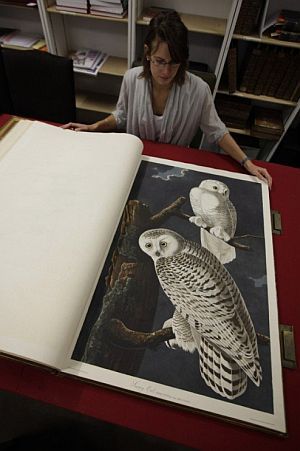
John James Audubon was, and still is, a giant in the field of painting wildlife. His work, The Birds of America, is one of the most expensive books one can purchase. First published as a series of plates, five at a time, from 1827 and 1838, the final book contains a massive 435 prints of life-sized birds (which is why some birds have very bent necks). With only 13 of a little more than 100 copies in private hands, the rarity, combined with the beauty and size of the original prints pushed the most recent auction price to just over a whopping 6.6 million USD. I have seen a copy in-person and felt that mere images of his art do not do his work justice. Seeing it in context of a book next to people, so a couple photos were chosen for just this reason.

If Audubon’s paintings ever seem lacking, it may be due to the fact that he appears, as far as I can tell, largely self-taught. He did apparently learn to use oils from John Steen, but this was 1822, well into his 30s, and clearly not foundational to his already developed bird painting, which was in watercolor. All this makes The Birds of America quite impressive.

It is worth keeping in mind that while Audubon was spark, the mind, the promoter, and the artist of the birds behind the book, he did not produce it all alone. For starters, over fifty of the pieces had background plants drawn by his assistant Joseph Mason. Also, as they are prints, the art needed to be etched, which was done by Robert Havell, Jr. and over fifty colorists worked in an assembly-line to turn each page vibrant. The text to accompany the prints, Ornithological Biography, or, An account of the habits of the birds of the United States of America, was written by Audubon and Scottish naturalist William MacGillivray.

Audubon is most famous for The Birds of America, but it is important to note that this was not his only work. After his work on birds, he worked on mammals, traveling west in 1843 to continue his work on a planned The Viviparous Quadrupeds of North America. Unfortunately he never completed his work, dying in 1851. He completed about half the paintings, his son completing the rest. Fortunately, we can still appreciate what he saw through both his writings and his artwork.
Aside from viewing his art, people can read what Audubon wrote in his journals. Not everything is the most relevant to nature, or even respectable in general, but he did show his environmental ethic through them. When traveling west, he wrote of the buffalo they saw, lamenting the aggressive hunting for their pelts. “Daily we see so many that we hardly notice them more than the cattle in our pastures about our homes. But this cannot last; even now there is a perceptible difference in the size of the herds, and before many years the Buffalo, like the Great Auk, will have disappeared; surely this should not be permitted.” In light of this, it is worth noting that his Birds of America does contain six birds now extinct, four of which humans hunted to extinction, the other two the result of pressures caused by humans.
You can read much more at Audubon.org
